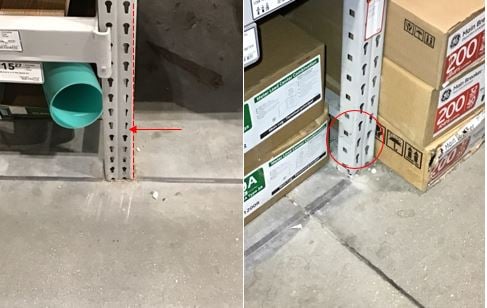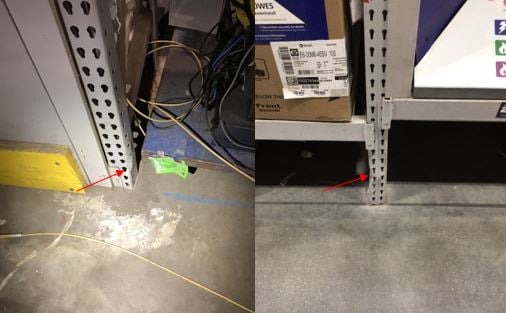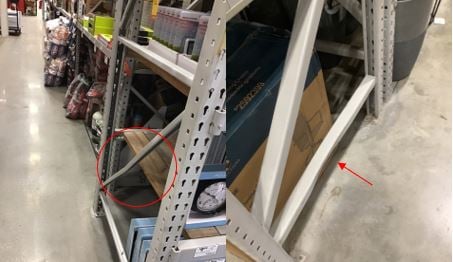After completing a rack safety inspection for your warehouse, you might have identified damage to the uprights, braces, beams, or other pallet racking components. What steps should you take next? Assessing the extent of deformation and determining the appropriate course of action can be complex. At Damotech, we recommend employing the 1-2-3 rule1 of thumb to establish the priority for addressing these damages. Curious about the 1-2-3 Rule? Are you wondering about its origin, utility, and application? All these inquiries will be answered in this blog post.
It's important to note that while the 1-2-3 rule serves as an informal guideline for warehouse racking inspections, it should not substitute the assessment carried out by an engineer. Various factors, including load capacities and seismic activity, influence rack performance. If you require guidance from a rack safety expert, consider using our engineering services.
What is the 1-2-3 Rule?
.jpg?width=1370&name=DAMO_SECTION_1-2-3_Poster-EN-(10-06-21).jpg)
This rule is an inspection guideline to evaluate the degree of deformation or deviation on upright elements. The name 1-2-3 refers to three distinct rack damage tolerance indicators (1/8”, 2/8”, and 3/8”) applicable to the front of the upright column, the sides of the upright column, and the braces (in any direction).
In short, the 1 2 3 rule states:
1. Rack column frontal deviation should not surpass 1/8”
2. Rack column lateral deviation should not surpass 2/8”
3. Rack brace deviation should not surpass 3/8”
Here are more detailed explanations of each guideline:
1. Rack Column Frontal Deviation Tolerance (1/8”)

Start with what is easiest to see: damage to the frontal part of a rack column. Examine the column carefully and check for deformation of over 1/8” within a span of 40 inches. This guideline refers to the frontal deviation of a column towards or away from the upright braces (upright depth).
This is not necessarily embedded in the rule, but you should also look for other types of damage like cracks, bulges, pinched columns, twists, and any sign of corrosion. Any of these are worth investigating with a 3rd party rack safety expert via a more thorough rack inspection. Engineers specializing in rack safety will look beyond the damage to certify that the rack systems comply with design and safety standards governing rack design.
2. Rack Column Lateral Deviation Tolerance (2/8”)

Any column side or lateral deformation of over 2/8” within a span of 40 inches to a rack column should be addressed promptly. Pay particular attention to damage that may be hidden behind beam connectors. This guideline refers to the lateral deformation of a column in the same direction as the aisle: to the right or the left when facing the column.
3. Brace Deviation Tolerance (3/8”)

A rack frame bracing consists of horizontal and/or diagonal members joining upright front and rear columns. The rack manufacturer carefully designs these members to stabilize the rack frame in the cross-aisle direction and support each column.
Any damage to racking braces can jeopardize the stability of an upright and could degrade the structural integrity of an entire racking system. Therefore, if a deformation in any direction is over 3/8” within a span of 40 inches, it should be addressed. A brace should also be repaired or replaced immediately if it is detached or missing.
Where Does the 1-2-3 Rule Come From?
The origin of the 1-2-3 rule comes from the guideline FEM 10.2.04 (European Materials Handling Federation). It advises a similar procedure for the assessment of rack damages. Specifically, it states that a 1-meter (~40”) straight ruler should be used to assess damage. For frontal damage, the deviation should not surpass 3mm (~1/8”). For lateral damage, the deviation should not surpass 5mm (~2/8”). For brace damage, the deviation should not surpass 10mm (~3/8”). The guideline states that any damage under these conditions is not considered critical. If damage is beyond these limits, it should be immediately addressed. It is important to note that there are plenty of exceptions, so it would be wise to talk to a rack specialist when in doubt.
Why Use the 1-2-3 Rule?
The 1-2-3 rule is a quick and simple rule of thumb to help you assess rack damage in your warehouse. Not only is it easy to remember, but it will make your inspection more concise! Use this method alongside an inspection checklist to make your rack damage assessment as hassle-free as possible.
When Should the 1-2-3 Rule Be Used?
The rule should be used when damage has been identified to determine if the deformation is beyond defined tolerances and define the priority level of the damage. For example, if the deformation is under the 1-2-3 rule of thumb, it might not be repaired immediately and should be monitored in the future for re-assessment. However, if it is over the defined tolerance, it should be addressed promptly by a rack professional. The rule should also be used during routine rack inspections. We recommend doing a monthly in-house inspection and getting a 3rd party in for a yearly rack inspection. Read more on when to get your pallet racks inspected.
Who Should Use the 1-2-3 Rule?
Safety is everyone's responsibility; hence, anyone can use the rule to assess damage in a warehouse. Preferably, whoever oversees your pallet rack routine inspections and has a 1-meter (~40”) measuring stick can use the 1-2-3 rule!
Rack Safety is a Shared Responsibility
Now that you know the 1-2-3 rule, you can use it during your next warehouse rack inspection. Remember that it’s a rule of thumb with many exceptions. Also, if you identify multiple issues or deviations on the same upright, the guidelines can no longer be followed, and an engineer should be brought in to further assess the security risks. If you want to learn more about damage assessment, consider booking a rack safety training session for you and your warehouse employees. Safety is everyone’s responsibility, and training your workforce on rack safety and rack damage assessment is one of the best investments your company can make to minimize unnecessary risk.
Rack Damage Assessment Questions
What indicators show a need for immediate rack repair?

How can racking damage be detected early?

Early detection relies on:
- Training staff to recognize visible signs of damage (using the 1-2-3 Rule).
- Regular in-house inspections between annual third-party audits.
- Digital inspection tools (Damotech Platform) to log anomalies, track issues, and set repair priorities.
- Monitoring high-traffic zones and impact-prone areas more frequently.

Notes:
- Please note that the 1-2-3 rule is also often called the 123 rule, 1 2 3 rule, or 1/2/3 rule when relating to pallet racking damage tolerances.
References:
CSA Group (Canadian Standards Association). (2017). User guide for steel storage racks. Toronto, Ontario, Canada. https://www.csagroup.org/











